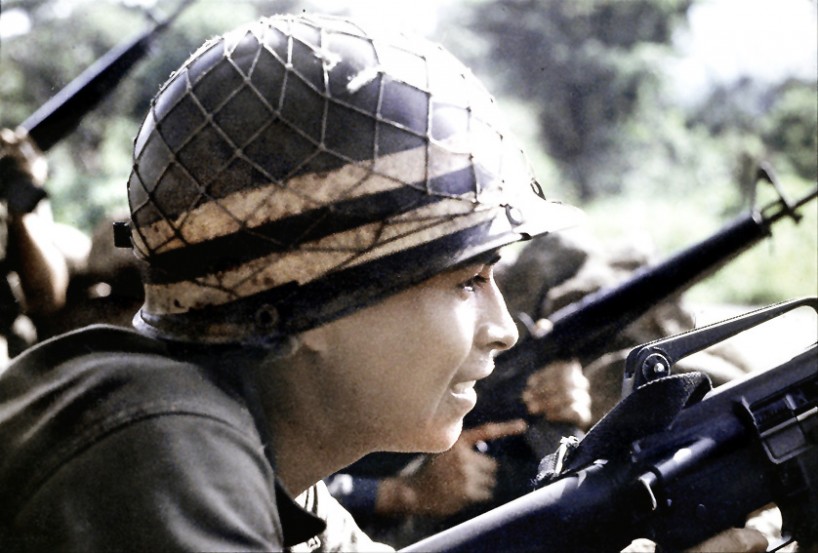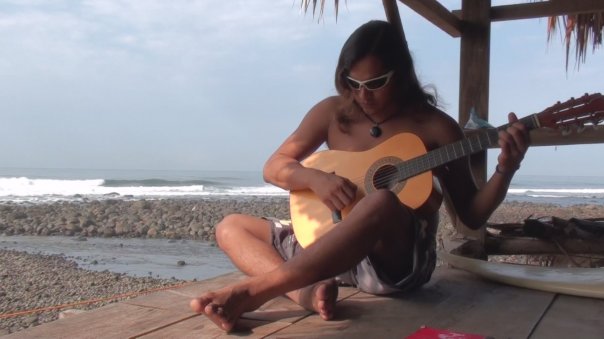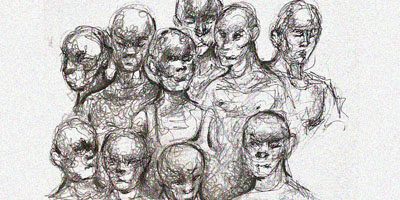The psychological and social rehabilitation and recovery of former child soldiers remains inadequate, and their personal struggles continue years after the armed conflicts end.
“The night the soldiers came to our village, they rounded up just us kids and told us we had to go with them, that our country needs us. The girls were separated from the boys and sent to ‘safe places’ to care for the dead and the wounded. We were taken to a military base and given an M16, which became our pillow and nightly companion for the months and years to come.”
Tore Martinez Figueroa, now 31, told me about the day he found himself enrolled in the Armed Forces of El Salvador (FAES). “I was almost 14, studying in the city, and surfing most afternoons. We were very poor, and my father was often away working. I grew up mostly with my friends and ‘doña Ela,’ a lady who looked after me.”

Photo: Gary Mark Smith. This photo was taken during a firefight in Chalatenango, El Salvador in 1982. The series of photos, “The Streets of the Cold War/ El Salvador,” is online at streetphoto.com.
Salvadoran law allows for compulsory military service at 18, but emergency directives during the war allowed voluntary enrollment from the age of 16. Civil war broke out in 1980 and lasted twelve years. Of 6 million people, 80,000 were killed and one million fled the country.
Now almost two decades later, Tore, like most of his compatriots, is trying to rebuild his life while still haunted by a not so distant past.
“Between hills and highways, mountains and towns, we kept running, looking for the guerrilla. As we ran, so did much blood from both sides. It was normal to see a kid get shot or die of hunger. Cutting heads was like cutting mangoes.”
It is generally acknowledged that both sides of the war drafted children, some younger than 16. Up to 80% of?the national armed forces and 20% of the rebel FMLN (Frente Farabundo Martí para la Liberación) combatants were under 18.
“I remember one night, walking with the other soldiers towards the city, we could see several parts of the capital in flames, helicopters disappearing in the smoke. I had been starving the whole day, and was wishing for the war to be over. But it never was.”
Today, an estimated 300,000 child soldiers are involved in more than thirty conflicts worldwide. Military commanders see child soldiers as “cheap, compliant and effective fighters,” according to Human Rights Watch. Their low level of cognitive maturity makes them less likely to contradict orders and more likely to be fearless.
As a war tactic, use of child soldiers can shock an enemy. They are universally recognized as society’s most precious asset and its future.
Lack of support
The successful rehabilitation and reintegration of former child soldiers into civilian society is a necessary first step in setting the foundations for lasting peace.
Many studies have analyzed the effects of exposing children to the ravages of war. The consequences of being torn away from family, friends and community and submerged in violence can include psychological, behavioural and emotional problems, especially when maladaptive coping mechanisms bring regressive and/or aggressive behaviour.
In 1998, a UNICEF-led survey in El Salvador revealed that 71% of child soldiers had received no support in their transition to civilian life. While various “Disarmament, Demobilization and Reintegration” programs are available in El Salvador, by 1999 fewer than 40% of the FMLN under-age combatants had been integrated into one, with only 5% completing it.
The lack of success was at least partly attributed to the low level of support of support from the international community, as well as a lack of follow-up at both the national and international levels. In addition, the local FAES officers insisted that even if there were soldiers under 18 years of age, they were all at least 16 and had joined voluntarily. The lack of recognition meant that many child soldiers weren’t eligible for the programs.
Going beyond the medical response
To find out what is being done now for child soldiers, I spoke with Dr. Duncan Pedersen who leads the international Trauma and Global Health (TGH) Program based at the Douglas Mental Health University Institute in Montreal. The program’s aims include reducing the mental health burden of civilian populations exposed to protracted and endemic political violence and fostering the process of healing, psychosocial rehabilitation and recovery.

It is a unique initiative, conducted in partnership between Canadian and developing country researchers, funded by the Global Health Research Teasdale-Corti Team Grant Program and supported by the Douglas Mental Health University Institute and McGill University. Its goal is to encourage policies that recognize that “exposure to armed conflict… carries not only physical burdens, but also great psychological and social ones.”
The program focuses on the impact of violence and sustained trauma on civilian communities. The percentage of civilians affected by war has been steadily increasing, and now are as high as 9 out of 10 casualties.
The team at the TGH questions assumptions that a purely medical model is the most appropriate one.
“A successful intervention would use the community itself as the point of departure, and involve indigenous resources, locally available. such as strong social support networks and local health workers, and include traditional healers and community-based leaders,” Dr. Pedersen told me. “Another important feature of a successful intervention is the understanding of local indicators of distress, instead of those identified by the American Psychiatry Association for Post Traumatic Stress Disorder.”
“The field of humanitarian intervention is shifting slowly, from a ‘refugee camp’ relief model, providing shelter, food, clean water, and medical supplies, to a more sustained, peace-building, development-oriented, long-range set of interventions. What we are lacking is an efficient and reliable intervention model in which many other sectors beyond medical services are included.”
In El Salvador, old problems and new threats continue to challenge the democratization process. Delinquency and non-political violence has increased since the signing of the peace accords. The lack of security threatens the legitimacy of the political system as citizens doubt the state’s ability to protect them.
An American study of PTSD looked at more that 2700 recorded interventions on treatment modalities, and found there was little or no evidence that current psychosocial and pharmacological therapies were effective.
“The conclusions were shocking for the medical community. The therapies were either completely neutral or, in some cases, actually more damaging than helpful,” Dr. Pedersen said. “In addition to the remarkable lack of agreement on treatment goals and best practices in dealing with emergency crises situations, the changes in the nature of conflict and the shifting paradigms of humanitarian interventions point to the urgent need to restructure our humanitarian responses, to build them to be not only more humane but more efficient. A transition beyond the medical response into justice, education, housing and work realms is badly needed, rather than assuming that the only consequence of being at war is PTSD.”
“My main memory of the war,” Tore told me, “is of the number of families that lost their homes, many of them at the same time dealing with deceased or lost family members. What I learned is that life is too precious to waste in war. Before, we had to run for our lives and kill to eat. Now, we struggle with no job, no way to make money, and a police system whose only role seems to be repressing the young, particularly those who express themselves with piercings or tattoos.”



